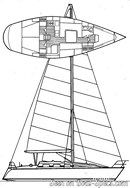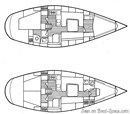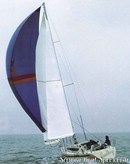Feeling 1100 Keel and centerboard
Sailboat specifications
The Feeling 1100 is a 35’11” (10.95m) cruising sailboat designed by Ron Holland Design (Canada). She was built between 1982 and 1987 by Kirié (France). The Keel and centerboard version features a centerboard inside of a short fin-keel allowing shoal draft while maintaining upwind capabilities.
The Feeling 1100 has also been marketed as Elite 37 and she is as well listed, on Boat-Specs.com, in Fin keel version (see all the versions compared).
The Feeling 1100 has also been marketed as Elite 37 and she is as well listed, on Boat-Specs.com, in Fin keel version (see all the versions compared).
Feeling 1100's main features
- Model
- Feeling 1100
- Version
- Keel and centerboard
- Hull type
- Monohull
- Category
- Offshore cruising sailboat
- Sailboat builder
- Sailboat designer
- Sailboat range
- Country
- France
- Construction
- GRP (glass reinforced polyester):
- Hull: Single skin fiberglass polyester
- Deck: Sandwich balsa fiberglass polyester - First built hull
- 1982
- Last built hull
- 1987
- Appendages
- Centerboard : pivoting centerboard in the keel
- Helm
- Single tiller (helm wheel in option)
- Rudder
- Single spade rudder
- Unsinkable
- No
- Trailerable
- No
- Former French navigation category
- 1
- Standard public price ex. VAT (indicative only)
- N/A €
Feeling 1100's main dimensions
- Overall length
- 37’ 1”11.3 m
- Hull length
- 35’ 11”10.95 m
- Waterline length
- 31’ 8”9.65 m
- Beam (width)
- 12’ 1”3.7 m
- Draft
- 6’ 11”2.1 m
- Draft when appendages up
- 4’ 1”1.25 m
- Light displacement (MLC)
- 12787 lb5800 kg
- Ballast weight
- 5291 lb2400 kg
- Ballast type
- Cast iron exterior ballast with steel centerboard
Feeling 1100's rig and sails
- Upwind sail area
- 828 ft²76.9 m²
- Downwind sail area
- 1449 ft²134.6 m²
- Mainsail area
- 297 ft²27.6 m²
- Genoa area
- 531 ft²49.3 m²
- Solent area
- 344 ft²32 m²
- Jib area
- 226 ft²21 m²
- Stormjib area
- 89 ft²8.3 m²
- Symmetric spinnaker area
- 1152 ft²107 m²
- JiFore triangle base (from mast foot to bottom of forestay)
- 14’ 10”4.5 m
- PiMainsail hoist measurement (from tack to head)
- 40’ 8”12.42 m
- EiMainsail foot measurement (from tack to clew)
- 13’ 4”4.04 m
- Rigging type
- Sloop Marconi masthead
- Mast configuration
- Deck stepped mast
- Rotating spars
- No
- Number of levels of spreaders
- 2
- Spreaders angle
- 0 °
- Spars construction
- Aluminum spars
- Standing rigging
- 1x19 strand wire
Feeling 1100's performances
- HN (French rating)iHN or "Handicap Nationale" is an empirical rating system used in France allowing various monohulls, of different sizes and designs, to race each other fairly. It is particularly suitable for cruiser and cruiser-racer. Therefore, by comparing these values, we can have an indication of the relative speed of 2 boats.
- 20.0
- Upwind sail area to displacementiThe ratio sail area to displacement is obtained by dividing the sail area by the boat's displaced volume to the power two-thirds.
The ratio sail area to displacement can be used to compare the relative sail plan of different sailboats no matter what their size.
Upwind: under 18 the ratio indicates a cruise oriented sailboat with limited performances especially in light wind, while over 25 it indicates a fast sailboat. - 256 ft²/T23.82 m²/T
- Downwind sail area to displacementiThe ratio sail area to displacement is obtained by dividing the sail area by the boat's displaced volume to the power two-thirds.
The ratio sail area to displacement can be used to compare the relative sail plan of different sailboats no matter what their size. - 449 ft²/T41.7 m²/T
- Displacement-length ratio (DLR)iThe Displacement Length Ratio (DLR) is a figure that points out the boat's weight compared to its waterline length. The DLR is obtained by dividing the boat's displacement in tons by the cube of one one-hundredth of the waterline length (in feet).
The DLR can be used to compare the relative mass of different sailboats no matter what their length:
a DLR less than 180 is indicative of a really light sailboat (race boat made for planning), while a DLR greater than 300 is indicative of a heavy cruising sailboat. - 183
- Ballast ratioiThe Ballast ratio is an indicator of stability; it is obtained by dividing the boat's displacement by the mass of the ballast. Since the stability depends also of the hull shapes and the position of the center of gravity, only the boats with similar ballast arrangements and hull shapes should be compared.
The higher the ballast ratio is, the greater is the stability. - 41 %
- Critical hull speediAs a ship moves in the water, it creates standing waves that oppose its movement. This effect increases dramatically the resistance when the boat reaches a speed-length ratio (speed-length ratio is the ratio between the speed in knots and the square root of the waterline length in feet) of about 1.2 (corresponding to a Froude Number of 0.35) . This very sharp rise in resistance, between speed-length ratio of 1.2 to 1.5, is insurmountable for heavy sailboats and so becomes an apparent barrier. This leads to the concept of "hull speed".
The hull speed is obtained by multiplying the square root of the waterline length (in feet) by 1.34. - 7.54 knots
Feeling 1100's auxiliary engine
- Engine(s)
- 1 inboard engine
- Engine(s) power (min./max.)
- 18 HP / 28 HP
- Fuel type
- Diesel
- Fuel tank capacity
- 19.8 gal75 liters
Feeling 1100's accommodations and layout
- Cockpit
- Closed aft cockpit
- Cabin(s) (min./max.)
- 2 / 3
- Berth(s) (min./max.)
- 8 / 10
- Head(s)
- 1
- Freshwater tank capacity
- 79.3 gal300 liters
- Fridge/ice-box capacity
- 26.4 gal100 liters
- Maximum headroom
- 6’ 1”1.87 m
- Head headroom
- 5’ 7”1.71 m
Feeling 1100's saloon
- Maximum headroom
- 5’ 11”1.81 m
- Saloon table length
- 3’ 8”1.14 m
- Saloon table width
- 3’ 1”0.93 m
Feeling 1100's fore cabin
- Maximum headroom
- 5’ 8”1.74 m
Feeling 1100's aft cabin
- Maximum headroom
- 5’ 11”1.81 m
- Berth length
- 6’ 5”1.95 m
- Berth width
- 4’ 7”1.4 m







Kirié Feeling 1100 interior and accommodations - - 6/6
Picture extracted from the commercial documentation © Kirié
Picture extracted from the commercial documentation © Kirié
Similar sailboats that may interest you:
Sailboats
First built hull
Hull length
2009
39’ 2”11.95 m
1982
35’ 11”10.95 m
1984
33’ 7”10.23 m
2015
36’10.98 m
2016
36’ 6”11.13 m
1983
30’ 2”9.2 m
2003
32’9.75 m
1999
32’ 10”10 m
1984
33’10.05 m
2011
36’10.98 m
2013
36’ 6”11.13 m
1982
36’ 8”11.2 m
1982
35’ 11”10.95 m
2003
32’9.75 m
1980
38’ 6”11.75 m